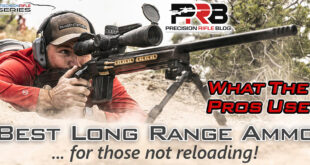What is the best primer? This is a perennial question for handloaders pursuing optimal accuracy, whether that is for a benchrest rifle, F-Class, or long-range tactical setup. The primer is likely the reloading component most shooters know least about, and when that is the case it is sometimes a good idea to just start by looking at what the experts are using.
I decided to aggregate the load data listed on 6mmBR.com for various cartridges, to see how many times each type of primer was referenced. I chose 6mmBR.com, for a few reasons:
- 6mmBR.com is respected in the shooting community and peer-reviewed
- The majority of the content is produced by experts in the field, so unlike other online sources … it isn’t just some random guy posting load data he claims is accurate and/or safe.
- The 6mmBR.com community isn’t satisfied with just “pretty good accuracy” … but instead seems very like-minded in the OCD pursuit of perfection, and the website typically only list loads found to produce exceptional accuracy.
Best Small Rifle Primers
The small rifle primer numbers above reflects the load data available on 6mmBR.com for the 6mmBR (6BR), as well as the 223 Remington and 223 Remington Ackley Improved. You can see that there are really just three different small rifle primers that were mentioned at least 10 different times:
- Remington 7½ – The only primer specifically marketed by Remington as “benchrest” quality. Lyman & Nosler classify this as a standard primer, but Hornady, Handloads.com, and Chuck Hawks classify it as a small rifle magnum primer. Remington says the compound is the same as the 6½, but with a thicker cup. (6 1/2 cup thickness is.020″, 7 1/2 is .025″)
- CCI BR-4 – Very similar to CCI’s standard small primer (CCI 400), but with a slightly thicker cup (.025″ instead of .020″) and stamped “Benchrest” to indicate it is “match quality.” I’ve personally used thousands of these, and have found them to be very consistent.
- Federal 205M – Federal’s “match grade” version of the 205. (Sometimes refered to as Federal GM205M)
Best Large Rifle Primers
The large rifle primer numbers above reflects the load data available on 6mmBR.com for the 243 Win, 308 Win, 6.5-284, 7mm WSM & 7mm SAUM. Although there were almost 60 different loads listed, there were clearly only 3 large rifle primers the experts trust for exceptional accuracy:
- Federal 210M – Listed for over 50% of the loads, this primer was clearly the most popular for super-accurate loads. It is Federal’s “match grade” version of its standard large rifle primer, the 210. (Sometimes refered to as Federal GM210M)
- Winchester WLR – This is said to be the hottest non-magnum primer, and is hard enough to be used in semi-autos. (Sometimes refered to as Winchester LR 8 1/2)
- CCI BR-2 – The “match” version of 200. This is also considered hard enough for use in semi-autos.
Best Large Rifle Magnum Primers
There weren’t enough loads on 6mmBR.com referencing large rifle magnum primers to provide an adequate sample size for a comparison. However, here are some of the magnum primers commonly used for match grade ammo (no particular order):
- Federal 215M – It is Federal’s “match grade” version of its standard large rifle magnum primer, the 215. (Sometimes refered to as Federal GM215M)
- CCI 250 – Although not marketed as part of CCI’s “benchrest” series, many say these primers produce good consistency for a magnum rifle.
- Winchester WLRM (Sometimes refered to as Winchester LRM or Winchester 8 1/2M)
 PrecisionRifleBlog.com A DATA-DRIVEN Approach to Precision Rifles, Optics & Gear
PrecisionRifleBlog.com A DATA-DRIVEN Approach to Precision Rifles, Optics & Gear







Hi Cal, which primer would be more reliable in colder hunting weather the Federal 210 or the 210M?
Regards,
Ted
That’s a great question, Ted. I’m not sure. Here is a couple examples of what I’ve heard in different places on the Federal 210 vs Federal 210M differences:
Personally, I use 210M’s or 215M’s when I go hunting, depending on the cartridge. It gives me peace of mind. But I don’t know if you’d ever see a measurable difference between the two. Primers are one of the cheapest components we buy, but can be critical to consistent muzzle velocities … so I usually don’t try to save what only amounts to a couple of pennies per round by choosing a standard primer over a match primer. Then again, just because it says “match” on it doesn’t mean it’s the best. I’ve learned that from experience! 😉
Hope this helps! Best of luck to you.
Thanks,
Cal